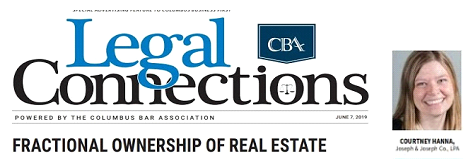By Courtney Hanna
 When purchasing a large asset, such as real estate, a party may want to make this purchase with other persons in order to mitigate the costs of paying for and maintaining the real estate, thereby creating a fractional ownership of real estate. This has become more common in the purchase of vacation homes where parties do not want to pay one hundred percent of the costs associated with homes that they can only visit for short portions of any given year.
When purchasing a large asset, such as real estate, a party may want to make this purchase with other persons in order to mitigate the costs of paying for and maintaining the real estate, thereby creating a fractional ownership of real estate. This has become more common in the purchase of vacation homes where parties do not want to pay one hundred percent of the costs associated with homes that they can only visit for short portions of any given year.
It is also common when multiple people want to come together to purchase investment property. However, just as in any purchase of an asset, fractional ownership does not come without some risks. When owning property with other individuals or entities, it is important to set up the ownership so that the parties know their share of ownership, their duties and responsibilities toward the property, what should happen in the event the fractional ownership breaks apart and, in the case of vacation homes, the times that they are able to use the vacation home each year and whether that time can be rented out to other parties.
A common way to purchase real estate when there is a fractional ownership is through an entity such as a limited liability company. An Operating Agreement would be entered into upon the formation of the company which creates a contract between the owners and provides for items such as the capital contributions of the parties (for example, the down payment made by each party for the purchase of the real estate), the allocation of shares of each party (i.e., the percentage of ownership each party has in the real estate), the division of roles as it relates to management and decision making, maintenance, payments, times to use the property, as well as what happens to the real estate, should the parties decide to terminate their relationship.
Another common way in which persons maintain fractional ownership of property is by Tenancy in Common. This is where more than one person is named on the deed to the property. However, complications arise when one party wants to sell the property, one party is no longer pulling their weight as it relates to their roles associated with the ownership of the property, or one party can no longer afford ownership of the property. In these cases, if the parties cannot agree as to what should happen with the property a Partition action would need to be fi led with the Court to divide the property, or if the property cannot be divided, then for the property to be sold at auction. It would be advisable that if you are not intending on creating an entity such as a limited liability company which provides for the day-to-day operations of the property and the resolution of the “breakup” of the fractional owners, that you do enter into an agreement or contract with the fractional owners to determine these same issues ahead of time.
Any parties that are considering purchasing property through a fractional ownership should contact an experienced Ohio real estate attorney and an accountant to determine the best course of action for them.
Also, check out some of our more in-depth Articles
Also, see:
Five Things You Must Know Before Buying or Selling Real Estate
Seller Financing in Ohio: Land Installment Contract v. Note and Mortgage – Part 1
Seller Financing in Ohio: Land Installment Contract v. Note and Mortgage – Part 2